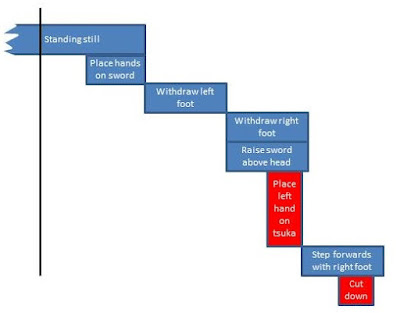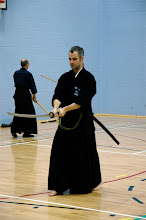As part of the BKA's Iaido Kyoshi exam, we were expected to learn, off-by-heart, all of the Chakuganten from the ZNKR Iaido Manual, not a particularly challenging task as there are only 40 points but made more difficult if
- You have the memory of a sieve
- You realise that each numbered item is probably making more than one point or criteria
- Furikaburi passes by the left ear.
- Furikaburi performed with a feeling of thrusting behind.
- While passing through chudan, does the rear foot move close to the front foot and is the thrust made effectively to the opponent’s solar plexus?
- Must pass through chudan.
- Rear foot moves close to the front foot (“okurikonde” does not mean “next to”).
- Thrust must be effective.
- Thrust must be to the solar plexus.
So having devoted a not insignificant number of brain cells to memorising all that and then doing the exam I remembered the aim of the kyoshi exam in the first place (which I co-wrote with Al Colebourn). Seeing as 7th dan Kyoshi was the highest grade of iaido of anyone in Europe, the idea was to ensure that if you held Kyoshi that you had memorised all of the important stuff from the ZNKR curriculum. Why? Because as the highest grades, they have the greatest responsibility to maintain their knowledge of the ZNKR curriculum, were able to "interpret" the text into meaningful instruction and demonstration...they were to be the gatekeepers in Europe for instruction of ZNKR Iai (at least that was the intention of the exam content).
Personally I still believe this is important and relevant. It is, or should be, the same aim for all iaidoka who take their development and study seriously, though it is the Kyoshi who need to be particularly attentive to this.
Anyway, during this period of serious self-motivation (I don't think I moved away from my desk for about a week, Pizza Express shares went up) I had a few conversations with my friend Robert Stroud Sensei from https://www.idaho-kendo.com/ fame. I cannot overemphasise the importance of the great work that Robert has done to surgically translated the ZNKR manual from Japanese into English being uber-careful about getting the nuance and detail as correct and appropriate as one can without turning the whole translation into a "Learn Japanese Slowly" manual. I heartily encourage you to visit his website, have a look around and buy him a coffee for his dedicated work.
Robert was finding some difficulty in harmonizing what was written in the manual with what was being taught at seminars. I have to say that we are extremely lucky to have had Ishido Sensei as a constant source of support, instruction and wisdom in all the years that he has been visiting Europe. He has always been able to give us all of the context and history to the development and delivery of ZNKR Seitei iaido and so where mismatches in logic or explanation have occurred, he has even been able to say the central meeting that this or that particular issue was discussed in Kisarazu (I think it was) where for years the content of the iaido manual was discussed and explored and its interpretation decided by the highest grades in Japan. With these years of Ishido Sensei tirelessly trying to hammer this information into our heads, I was able to discuss what some of the directions of understanding were with a few of the issues that he had found.
If you have found yourself with nothing to do, with no friends, no options in life and with only a few shekels to spend on bread crusts and bacon rinds then you might have found yourself at one of my iaido seminars in the last few years where I have monologued about one of the kata in particular where the explanation in the manual has consistently failed to be met with a correct performance of the kata. In fact, if you have been kidnapped by bandits and have been locked in a room with only a laptop for company then you might have even drifted through the following post I wrote years ago, shallowly covering the same topic:
https://iaidojodotraining.blogspot.com/2011/02/iaido-training-session-47.html
But I thought now was a good time to come back to this topic and join Robert in the quest to make some sense of some of the less-obviously-difficult parts of certain kata. And so, here is my view on ZNKR No.12 Nukiuchi.
I should first lay out what my opinion is regarding the ZNKR Manual, it is a written guide for how to do ZNKR Seiteigata Iaido to establish some consistency between teachers. Therefore, while it doesn't teach you how to walk, there is supposed to be adequate detail in there so that the majority of people are doing these kata consistently with each other for most of the time (the clear exception is the method of noto and sageo sabaki which are to be performed in accordance with your koryu/teacher lineage).
Since the manual was produced there have been ongoing efforts to clarify any points which are not completely detailed; these efforts have consisted of written and spoken detail usually originating from central iaido seminars in Japan and directed by the ZNKR Iaido Committee. So we should be comfortable with the fact that the interpretation of some points has been made outside of the manual.
These points however are in general for where there is a lack of clarity and detail in the manual; the manual however is extremely detailed both in terms of what is written and how it is written. There are some aspects of Japanese grammar which are difficult to translate into languages such as English without losing the subtle nuance. As an example, the translation of "while" in English goes several ways in Japanese and trying to get those differences back into English can cause the sentence to become bloated. To illustrate this:
- テレビを見ながらお茶を飲みました - Terebi wo minagara ocha wo nomimashita
- お茶を飲みながらテレビを見ました - Ocha wo nominagara terebi wo mimashita
- 皿洗いをしている間に鳩が部屋に飛び込みました - Sara'arai wo shite iru aida ni hato ga heya ni tobikomimashita
- 右足を踏み込むと同時に真っ向から切り下ろす - Migi ashi wo fumikomu to douji ni makkou kara kiri orosu
- While watching TV I drank some tea
- While drinking tea I watched some TV
- While I was washing the dishes a pigeon flew into the room
- While stepping the right foot forwards cut vertically down
- It is while I was already watching TV that I drank some tea
- It is while I was drinking tea that I started to watch some TV
- It was during the act of washing the dishes that a pigeon flew into the room
- Exactly at the same time that you step the right foot forwards you must cut vertically down
- This sentence is stating that in the pre-existing state of watching TV, some tea was drunk at the same time, both of these events took some tangible duration and there was some simultaneity involved.
- As 1. above but this time it was in a pre-existing state of watching TV that some tea was then drunk.
- This sentence is indicating that some action was being undertaken which took some tangible duration (washing the dishes) and there was an instantaneous event which occurred (the pigeon flew into the room)
- This sentence dictates that two actions take place at the same time, there are no pre-existing states, they are both carried out at the same time.
- Soutai shite chokuritsu shite iru zenpou no teki ga, totsuzen, kirikakate kuru no wo (In response to the descending cut suddenly by an enemy confronting you from the front...)
- katana wo nukiagenagara shirizoite (...while drawing the sword up, withdraw...)
- teki no katana ni kuu wo kirase (...and make/let the enemy's sword cut the empty space...)
- sara ni makkou kara kiriorosu. (...and then, cut down vertically)
- Subclause 1 indicates that the enemy standing in front of you moves towards you and commences a cut and your next movements are in response to the cut.
- Subclause 2 indicates that during the action of drawing the sword up (emphasis on drawing up), you move back.
- Subclause 3 indicates that by moving away from your initial position you allow the opponent's sword to cut through that vacated space.
- Subclause 4 then emphasises "and then" do kirioroshi.
5. Chokuritsu shita mama subayaku katana ni te wo kakeru, (From the same position i.e., without moving, sharply place your hands on the sword...)
6. hidari ashi wo kouhou ni hiki, (...pull the left foot back...)
7. migi ashi wo hidari ashi chikaku ni hikiyosenagara katana wo subayaku zujou ni nuki ageru to- (while drawing back the right foot close to the left foot, sharply draw the sword up above the head and...)
8. douji ni hidari te wo tsuka ni kake, (...at the same time place the left hand on the tsuka...)
9. ma wo oku koto naku migi ashi wo fumikomu to douji ni makkou kara kiriorosu. (...then, without any delay step forwards with the right foot at the same time as cutting down vertically.)
Again, please allow me to point out how the critical timing references, commas and sequences add nuance to the subclauses:
- Subclause 5 indicates that the hands go on the sword while not moving the body (the "chokuritsu shita mama" meaning "while remaining upright").
- Subclause 6 has a sequential verb (omitting the -te but basically meaning the same thing), with a comma after it indicating that this movement is done singly without much else taking place.
- Subclause 7 indicates that the right foot is drawn back close to the left, during this action the sword is sharply drawn up above the head.
- Subclause 8 indicates with "to douji ni" that as a relatively short duration movement, the left hand is placed on the tsuka at some point during the raising of the sword.
- Subclause 9, being preceded by a sequential verb means this happens next, "ma wo oku koto naku" means without delay so while this movement happens after the previous one, one should not stop moving between these movements. Again "to douji ni" joins the stepping forwards with the cutting down with the suggestion that the cut takes a relatively shorter time than the stepping forwards.
- Katana wo nukiageta toki, hidari ashi wo juubun ni gohou ni hiite iru ka (When the sword is drawn up, is the left foot withdrawn back adequately?)
- Katana wo nukiageta toki no, migi te no ichi wa seichuusen ni natte iru ka (When the sword is drawn up (by the right hand), is the right hand "becoming" (following) the centreline?)
- Hands go on the sword without moving the body.
- Left foot moves back while the sword is elevated up (only elevated, not drawn)
- Right foot moves back while the sword is drawn up above the head.
- Using te-no-uchi, at the moment of sayabanare a gentle squeeze should bring the sword close to horizontal smartly at the moment that the right foot reaches its objective position close to (not next to) the left foot.
- Immediately, the left hand joins onto the tsuka, the right foot moves forwards and kirioroshi is made.







